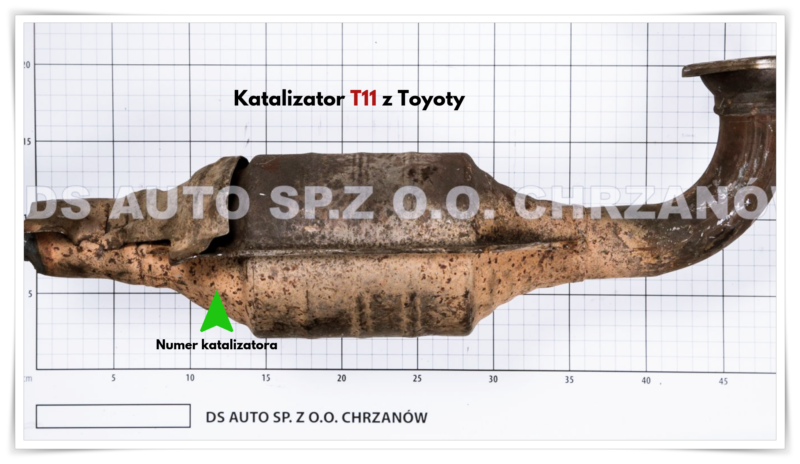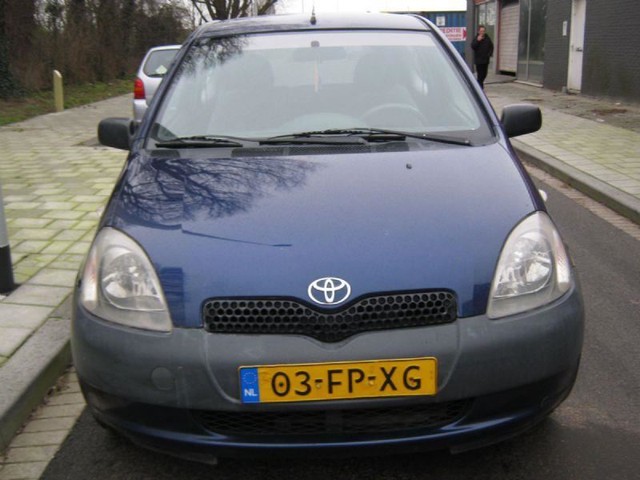Catalyst number T11 most often found in Toyota Yaris with 1.0 petrol engine, which has been produced since 1999.
Its elongated form has approx. 52 cm. A special feature of this catalyst is one of the outlets, which shape resembles a shorter and smaller version of the tube. The current price of this catalyst can be checked on our website.

Toyota Yaris it was first presented in 1997 at the Frankfurt Motor Show as a prototype car called Funtime Concept.
However, the debut version of the sales model first appeared at the Paris Motor Show in 1998.
Depending on the continent in which the described model appeared, you could meet with territorially given names:
Asia-Vitz
Australia- Echo
USA, Canada – Belta
Europe and North America – Yaris.
On our European roads you could meet hatchback models in 3 and 5 doors. The arrival of the new Toyota model was associated with the desire to replace the Starlet, which has been on the market for 26 years.
The main motto of the Yaris model production was modern design and the latest technology.
According to the manufacturer, the car has 100% met its assumptions, although its development phase is based on 3 generations of the Toyota model.


The first generation of the model was characterized by a fairly high body, which despite its originality was very stylish. The interior of the vehicle offered a large space and multi-functionality of the devices it contained.
Toyota Yaris I was offered in several gasoline and one diesel engines.
In gasoline you can find engines with a capacity of 1.0, 1.3, 1.5 with power from 68-150 HP.
Diesel offered a 1.4 unit with 75HP.
The car quickly gained popularity. The number of orders exceeded production resources.
In 2000, Toyota Yaris received the title of European Car of the Year, where it was mainly recognized for its capabilities in terms of safety and customer satisfaction.
The huge success of Yaris caused that Toyota decided to launch another model this time in a 3 door version of the hatchback hot hatch called Toyota Yaris T Sport.
The sports version of the flagship model was also very popular.
In 2001, the sports vehicle became a leader in its field, the main reason for its success was the unusually fast momentum of the vehicle.
In 2003, Toyota Yaris underwent a face lifting. The biggest surprise turned out to be Japanese expansion of the 1.0 engine into the Multi-mode Manual Transmission system, which allowed the selection of automatic or manual gear shifting. In this availability, the car consumed even less fuel.
Production innovation introduced to the Yaris model meant that a quarter of the total Toyota sales was this model.
In Europe, the first generation sold like fresh rolls, more precisely, in the number of 1.2 million units sold in Europe alone.
The second generation of the model debuted in 2005 and from the beginning you could see even greater precision in meeting the expectations of even the most demanding customers. Larger dimensions of the vehicle were also used in the interior. The multifunctionality of the car means, above all, independent adjustment of the seats, thanks to which you can achieve increased parameters for the luggage space, for loading by completely lowering the backrest to a flat surface of the floor, or comfortable placing of the legs in the passenger position.
Toyota Yaris in terms of security offered up to 9 airbags and thus received the highest Euro NCAP rating in the form of 5 stars.
As in the case of the first generation, the model was offered in the 3 and 5-door hatchback version, several engine versions were modernized, the most frequently purchased were 1.1 engines with 3 cylinders with 69 hp, 1.3, which was already used in the first generation of the model, as well as the engine 1.4 diesel with 91 hp.
An important aspect at Toyota Yaris was to equip the model with Toyota Optimal Drive technology, which reduced carbon dioxide emissions to a maximum of 120g / km.
The third generation of the model began its adventure in 2011 during the Geneva Motor Show.
This time the manufacturer proposed 3 types of drives: gasoline, diesel and hybrid.
A total change in the style of the vehicle, which consisted of a longer wheelbase, shorter overhangs and a lower roof caused that this generation of the model gained a more sporty appearance.
The reduced weight of the vehicle by 20 kg, or the reduced drag coefficient to 0.287, as well as once again obtaining the maximum safety rating shows the highest class among urban vehicles.
The original Toyota Optimal Drive technology has allowed us to continue to reduce fuel consumption and emissions without reducing power and torque.
The modern hybrid drive that was used in the third generation model debuted in 2012. The total power of this drive was 100 HP. Thanks to the support of the electric motor, Yaris has become the most economical combustion car.
Its average fuel consumption is 3.7 l / 100 km, and carbon dioxide emissions are 79 g / 100 km. In 2014, after the introduction of face lifting, the manufacturer tried to further reduce fuel consumption to 3.3 l / 100 km, in the city even 3.1 l / 100 km. In addition to these changes, you can also see the modernized interior design made of better quality finishing materials.
Toyota Yaris from the debut version to the present is a solid and durable car. With proper care of the vehicle, you can count on its long operation with relatively low maintenance costs. A definite plus of the vehicle is the continuing reliability and functionality among Toyota, as well as the spacious interior.
The downside may be a soft and delicate varnish, which with the above-described vehicle details turns out to be a small defect.

 Phone number:
Phone number:  E-mail:
E-mail:  A stationary point:
A stationary point:  Getting from the customer:
Getting from the customer:  XRF analysis spectrometer:
XRF analysis spectrometer:  Valuation by numbers:
Valuation by numbers: 